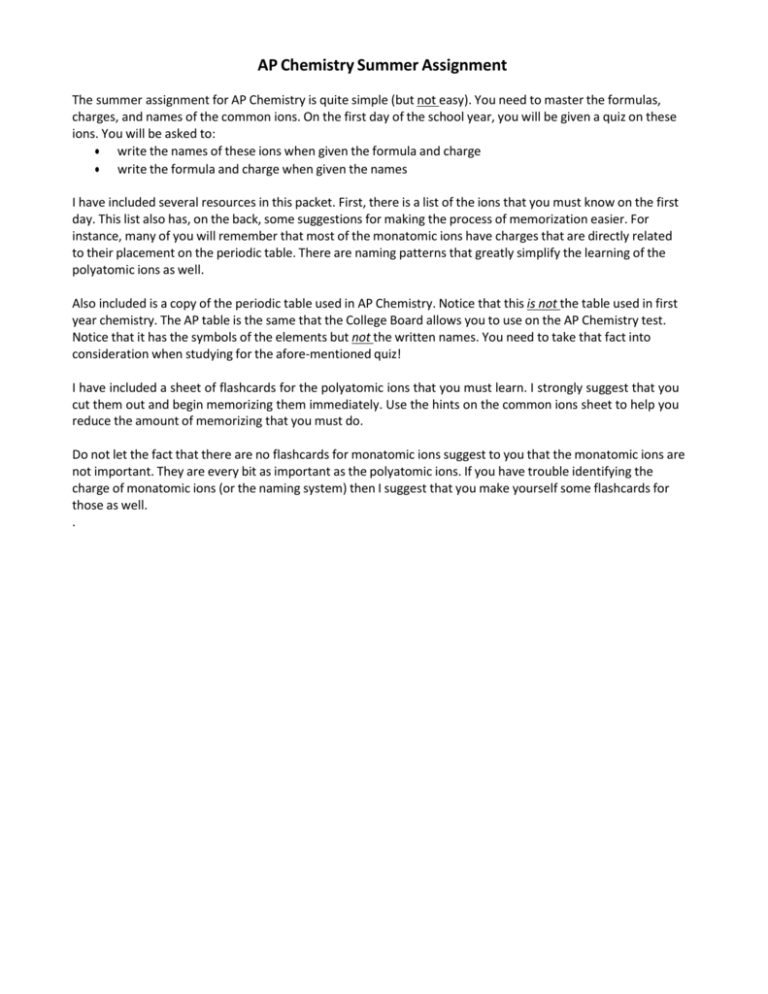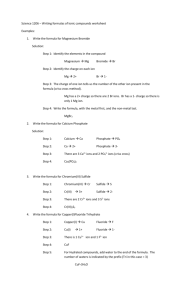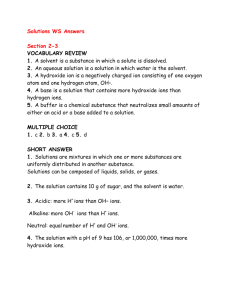Memorizing Ions Worksheet
advertisement

AP Chemistry Summer Assignment The summer assignment for AP Chemistry is quite simple (but not easy). You need to master the formulas, charges, and names of the common ions. On the first day of the school year, you will be given a quiz on these ions. You will be asked to: write the names of these ions when given the formula and charge write the formula and charge when given the names I have included several resources in this packet. First, there is a list of the ions that you must know on the first day. This list also has, on the back, some suggestions for making the process of memorization easier. For instance, many of you will remember that most of the monatomic ions have charges that are directly related to their placement on the periodic table. There are naming patterns that greatly simplify the learning of the polyatomic ions as well. Also included is a copy of the periodic table used in AP Chemistry. Notice that this is not the table used in first year chemistry. The AP table is the same that the College Board allows you to use on the AP Chemistry test. Notice that it has the symbols of the elements but not the written names. You need to take that fact into consideration when studying for the afore‐mentioned quiz! I have included a sheet of flashcards for the polyatomic ions that you must learn. I strongly suggest that you cut them out and begin memorizing them immediately. Use the hints on the common ions sheet to help you reduce the amount of memorizing that you must do. Do not let the fact that there are no flashcards for monatomic ions suggest to you that the monatomic ions are not important. They are every bit as important as the polyatomic ions. If you have trouble identifying the charge of monatomic ions (or the naming system) then I suggest that you make yourself some flashcards for those as well. . Common Ions and Their Charges A mastery of the common ions, their formulas and their charges, is essential to success in AP Chemistry. You are expected to know all of these ions. You will always be allowed a periodic table, which makes indentifying the ions on the left “automatic.” For tips on learning these ions, see the opposite side of this page. From the table: Cations H++ Li Na+ K+ + Rb Cs+ Be2+ Mg2+ Ca2+ Ba2+ Sr2+ Al3+ Anions - H F- Cl BrIO2S2Se2N3P3As3Type II Cations Fe3+ Fe2+ Cu2+ Cu+ Co3+ Co2+ Sn4+ Sn2+ Pb4+ Pb2+ Hg2+ Name Hydrogen Lithium Sodium Potassium Rubidium Cesium Beryllium Magnesium Calcium Barium Strontium Aluminum Name Hydride Fluoride Chloride Bromide Iodide Oxide Sulfide Selenide Nitride Phosphide Arsenide Name Iron(III) Iron(II) Copper(II) Copper(I) Cobalt(III) Cobalt(II) Tin(IV) Tin(II) Lead(IV) Lead(II) Mercury(II) Ions to Memorize Cations Name + Ag Silver 2+ Zinc Zn 2+ Mercury(I) Hg2 NH4+ Ammonium Anions NO2NO3SO32SO42HSO4OHCNPO43HPO42H2PO4NCSCO32- HCO3 ClO- ClO2 ClO3ClO4BrO- BrO2 BrO3BrO4IOIO2IO3IO4C2H3O2MnO4Cr2O72CrO42O22C2O-42NH2 BO33S2O32- Name Nitrite Nitrate Sulfite Sulfate Hydrogen sulfate (bisulfate) Hydroxide Cyanide Phosphate Hydrogen phosphate Dihydrogen phosphate Thiocyanate Carbonate Hydrogen carbonate (bicarbonate) Hypochlorite Chlorite Chlorate Perchlorate Hypobromite Bromite Bromate Perbromate Hypoiodite iodite iodate Periodate Acetate Permanganate Dichromate Chromate Peroxide Oxalate Amide Borate Thiosulfate Tips for Learning the Ions “From the Table” These are ions can be organized into two groups. 1. Their place on the table suggests the charge on the ion, since the neutral atom gains or loses a predictable number of electrons in order to obtain a noble gas configuration. This was a focus in first year chemistry, so if you are unsure what this means, get help BEFORE the start of the year. a. All Group 1 Elements (alkali metals) lose one electron to form an ion with a 1+ charge b. All Group 2 Elements (alkaline earth metals) lose two electrons to form an ion with a 2+ charge c. Group 13 metals like aluminum lose three electrons to form an ion with a 3+ charge d. All Group 17 Elements (halogens) gain one electron to form an ion with a 1- charge e. All Group 16 nonmetals gain two electrons to form an ion with a 2- charge f. All Group 15 nonmetals gain three electrons to form an ion with a 3- charge Notice that cations keep their name (sodium ion, calcium ion) while anions get an “-ide” ending (chloride ion, oxide ion). 2. Metals that can form more than one ion will have their positive charge denoted by a roman numeral in parenthesis immediately next to the name of the Polyatomic Anions Most of the work on memorization occurs with these ions, but there are a number of patterns that can greatly reduce the amount of memorizing that one must do. 1. “ate” anions have one more oxygen then the “ite” ion, but the same charge. If you memorize the “ate” ions, then you should be able to derive the formula for the “ite” ion and vice-versa. a. sulfate is SO4-2- , so sulfite has the same charge but one less oxygen (SO-32-) b. nitrate is NO3 , so nitrite has the same charge but one less oxygen (NO2 ) 2. If you know that a sufate ion is SO 42- then to get the formula for hydrogen sulfate ion, you add a hydrogen ion to the front of the formula. Since a hydrogen ion has a 1+ charge, the net charge on the new ion is less negative by one. a. Example: HPO 42H2PO 4PO43phosphate hydrogen phosphate dihydrogen phosphate 3. Learn the hypochlorite chlorite chlorate perchlorate series, and you also know the series containing iodite/iodate as well as bromite/bromate. a. The relationship between the “ite” and “ate” ion is predictable, as always. Learn one and you know the other. b. The prefix “hypo” means “under” or “too little” (think “hypodermic”, “hypothermic” or “hypoglycemia”) i. Hypochlorite is “under” chlorite, meaning it has one less oxygen c. The prefix “hyper” means “above” or “too much” (think “hyperkinetic”) i. the prefix “per” is derived from “hyper” so perchlorate (hyperchlorate) has one more oxygen than chlorate. d. Notice how this sequence increases in oxygen while retaining the same charge: ClOhypochlorite ClO2chlorite ClO 3chlorate ClO4perchlorate I no NOT OF.TA C:H FROM ROOK. PERIODIC TABLE OF THE ELEMENTS I 2 H He 1.008 3 4 6 7 8 9 4.00 10 Li 5 Be B c N 0 F Ne 6.94 11 9.01 12 10.81 13 12.01 14 14.01 15 16.00 16 Al Si p Na i\·lg r(, ' Cl 0 0 z -< 0 -< 22.99 24.30 19 20 -< -: Cl m 29 30 Cr i\·ln Fe Co Ni Cu Zn Ga 52.00 42 54.94 43 58.?3 58.69 63.55 65.3') If).72 45 46 47 48 49 Nb Mo Tc Ru Rh Pd Ag Cd In 92.91 IOI.I 102.91 106.42 76 71 78 Os Ir Pt 22 23 24 K Ca Sc Ti v 39.10 37 4-0.08 38 44.96 47.90 40 50.94 41 Rb Sr y Zr 85.47 87.62 8$,.91 9 1.22 55 56 l7 Cs Ba *La Hf 39 72 138.91 178.49 89 104 25 73 74 (981 75 Ta \V Re 95.94 180.95 183.85 186.21 105 106 107 26 55.85 44 107.87 1 12.4 1 1 14.32 79 81 80 Au Hg 137.33 87 88 Fr Ra tAc Rf Db Sg Bh Ds Rg C2l.3) 226.02 221.03 (261) (262) (266) (264) (277) (2()8) (271) (272) 58 59 60 61 62 63 64 65 66 Ce Pr Nd Eu Gd Tb Dy •Lanth ,11ide Series 140.12 140.9 1 91 90 tActinide Series Th 232.04 Pa 144.24 92 u 23 1.04 238.03 190 .2 108 109 Hs Mt Pm Sm ( 145) 93 191.2 150.4 94 Tl 195.08 196.97 200.59 204.38 110 111 132.9 1 m z x 28 I : J: m 2' 26.98 31 151 97 157.25 158.93 162.50 98 97 96 9S 28.09 32 30.97 33 Ge As 72.59 74.9? 50 51 Sn Sb 1 18.71 12 1.75 s 32.06 19.00 17 Cl Ar 35.45 39.95 34 35 36 Se Br Kr 78.96 52 79.90 53 83.80 54 Te 127.60 I Xe 126.91 131.29 86 82 83 84 85 Pb Bi Po At Rn (2IO) (2?2) 207.2 208.S1! /209) 67 68 69 Ho Er Tm 70 71 Yb Lu 164.93 167.26 168.93 173.04 174.97 100 10 1 102 103 99 Np Pu Am Cm Bk er Es Fm Md No Lr (237) (244) (247) (251) (252) (257) (258) (259) (262) (2(]) (247) 20.18 18 Sulfite Sulfate Hydrogen sulfate Phosphate Dihydrogen Phosphate Hydrogen Phosphate Nitrite Nitrate Ammonium Thiocyanate Carbonate Hydrogen carbonate Borate Chromate Dichromate Permanganate Oxalate Amide Hydroxide Cyanide Acetate Peroxide Hypochlorite Chlorite Chlorate Perchlorate Thiosulfate HSO4- SO42- SO32- HPO42- H2PO4- PO43- NH4+ NO3- NO2- HCO3- CO32- NCSSCN- Cr2O72- CrO42- BO33- NH2- C2O42- MnO4- C2H3O2CH3COO- CN- OH- ClO2- ClO- O22- S2O32- ClO4- ClO3-





